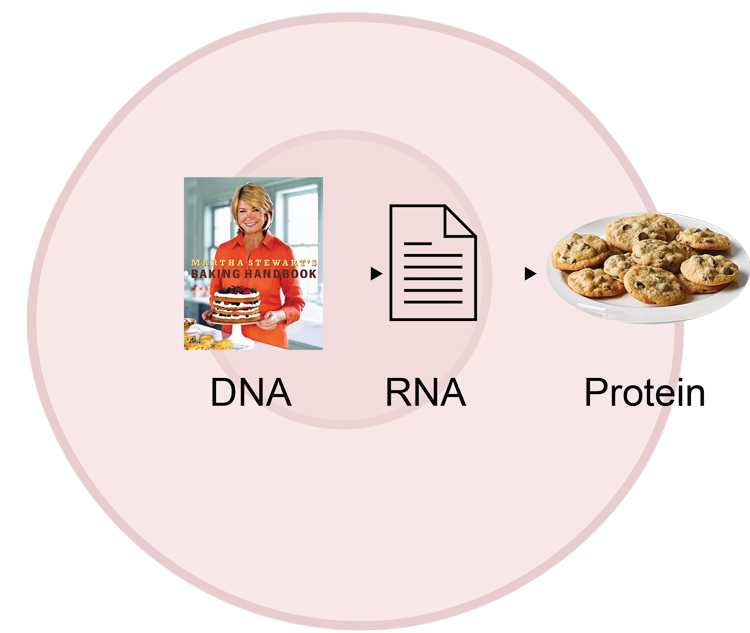Before diving into the complexities of HIV biology, it is important to understand the basic tenets of biology—how we use genetic information to produce fully-functional proteins, or what is known as the “central dogma” of biology. Deoxyribonucleic acid (DNA) is the genetic code in all cells’ nuclei that encodes for everything our cells—and bodies—need to function. The DNA code is read by cells and messenger molecules called ribonucleic acid (RNA) are made. These messenger RNAs can leave the nucleus and be read by other machinery to produce proteins of various functions. In skin cells, this protein might be melanin for UV protection or for hair follicle cells, this protein might be keratin that forms the hair itself. For CD4+ T cells—the immune cell infected by HIV—these proteins may be the various chemokines and cytokines needed to fight off infection.
This process of reading DNA to make RNA and finally protein can be thought of much the same as reading a recipe book to cook a meal. DNA is the recipe book containing all of the recipes needed to make a meal, but we don’t necessarily want to take this recipe book into the kitchen—it takes up far too much space on the counter and we don’t want to risk getting the book dirty. Instead, a photocopy of the recipe is made and brought into the kitchen to read, just like how DNA is copied into RNA that is transported across the cell to make protein whilst the DNA cookbook stays put on the bookshelf (the cell’s nucleus). In biology, the process of making RNA from DNA is called “transcription” as DNA and RNA are the same language as each other, whereas making protein from RNA is called “translation”—languages switch from RNA (or, words in a recipe book) to protein (the actual meal that is made). Every time a cell needs to make a protein, it will transcribe the recipe from its DNA into RNA which will then be translated into the protein it needs.
So, what about HIV? Unlike humans’ DNA genome, HIV has an RNA-based genome. This means that after HIV binds to its receptors (CD4 and CCR5 or CXCR4) on the surface of a CD4+ T cell and releases its cargo into the cell, the virus needs to convert its RNA into DNA for the viral recipes to be in a language that the cell understands. To do this, the virus uses its reverse transcriptase enzyme to reverse transcribe the RNA into DNA. This step is said to go against the central dogma of biology and is why HIV is classified as a “retrovirus.” Reverse transcriptase inhibitors act to block the virus from converting its RNA genome into DNA. Importantly, reverse transcriptase is an incredibly error-prone enzyme, quickly creating mutations that can lead to drug resistance. In fact, HIV is such an error-prone virus that the genetic diversity seen in a single individual living with HIV is greater than the genetic diversity seen with COVID-19 globally.
Once HIV reverse transcribes its RNA genome into DNA, another unique aspect of HIV biology occurs: integration. HIV’s integrase enzyme integrates its viral DNA into the infected cell’s DNA so that it is permanently embedded in the cell’s genome, analogous to someone sticking in their own recipe into our recipe book. From here, the cell does not recognize that there is anything wrong with its DNA; it sees a recipe, reads it and produces the meal that the recipe encodes for. Except, this time the cell is making new HIV virions rather than the proteins it needs for its function. This is much the same as when Rachel, from the TV show, Friends, one Thanksgiving wants to prove her skills in the kitchen by making a trifle but halfway through a recipe for trifle with cream and berries, the pages of her cooking magazine get stuck together. So, when Rachel goes to turn the page, she accidentally starts reading a recipe for shepherd’s pie and ends up making a half-trifle, half-shepherd’s pie Thanksgiving meal.
Importantly, all current licensed antiretroviral therapy (ART) drugs—except for the newly approved lenacapavir—act pre-integration. Fusion inhibitors, CCR5 antagonists and post-attachment inhibitors prevent a virus from binding to and fusing itself with a cell. Reverse transcriptase inhibitors prevent a virus from converting its RNA genome into DNA, and integrase inhibitors prevent HIV from integrating its DNA into the cell’s. Protease inhibitors prevent another viral enzyme, protease, from maturing an HIV virion so it is unable to infect a new cell. Combinations of these drugs are incredibly effective at preventing cells from being infected except since they all act pre-integration, they cannot do anything for a cell that is already infected with HIV DNA integrated into its DNA. Once a cell is infected with HIV, it will remain infected as long as the cell survives and if the cell divides, so too does HIV. The cells that HIV infects, CD4+ T cells, are incredibly long-lived and divide a lot as part of our immune response; we want an immune cell to live for a long time in case we encounter a pathogen again and if we do encounter a pathogen, we want our immune cells to divide a lot to fight off the infection throughout our body. Unfortunately though, this is also why HIV is a lifelong infection and why ART alone does not cure HIV. How these infected cells are able to survive and divide for so long is the topic of much scientific research.
Jared Stern, PhD has been living with HIV since 2015 and has been involved in HIV advocacy and HIV research since 2016. They are currently a post-doctoral research fellow at the Fred Hutchinson Cancer Center, investigating the mechanisms of persistence of the latent HIV-1 reservoir in people living with HIV on suppressive antiretroviral therapy. Jared is passionate about basic science research, fostering strong relationships between HIV researchers and community, and improving the autonomy of people living with HIV through scientific literacy to combat stigma.



